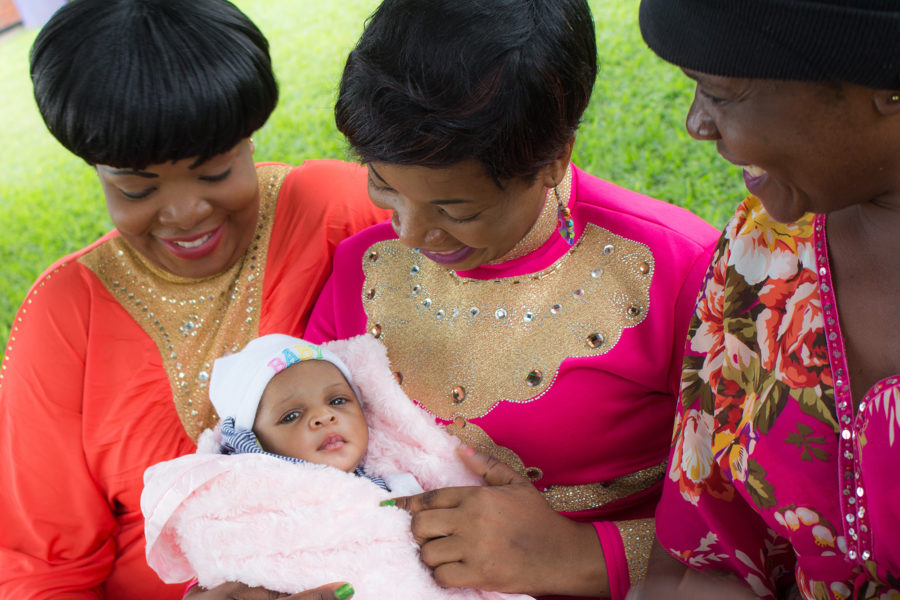Three Mother’s Story
The first things we noticed were the bright, colourful, and vibrant dresses. Beautiful colours of orange and pink accompanied by matching lipsticks greeted us. The three women sat down in front of us each with a different demeanour.
The first woman held the tiny baby in her arms while rocking the child to sleep. The woman next to her sat with her hands crossed, looking uncertain. The third woman sat back comfortably and watched the other two with curiosity. The three women presented a little girl who they said was born with clubfoot.
After examining the child, they were advised to return to CURE to visit the clubfoot clinic. While at the clinic, they would be able to meet other families whose children were born with the congenital defect.
When the three women and the baby returned, they wore more beautifully coloured dresses. The trio was definitely a tight group of women. The baby looked tiny in her little blanket, but at just a few weeks of age, she was a great candidate for the Ponseti treatment.
After chatting to the women, it became clear who the women were and how they were all related. The woman who had been carrying the baby since they first visited CURE was actually the aunt, who’s name was Ellen. The lady who sat in a relaxed manner was called Sylvia, and she was the cousin to the mother of the baby. The mother of the baby was, in fact, the lady in the beautiful, bright orange dress called Marceylls. She sat quietly and kept her arms together. Two sisters and a cousin came to visit CURE for this baby girl!

When asked why Ellen always holds the baby. The little girl’s mother started looking down at her feet. There was a sense of discomfort and impatience, and she would flinch every time she heard a baby crying.
“Because we are all Memory’s mothers, and we each have a role to play,” Ellen said.
In Africa, there is a saying, “It takes a village to raise a child.” A few days before a woman gives birth, it is tradition that a close female relative moves in with an expectant mother, so that they both help take care of the baby.
Ellen, who was the older sister to Marceylls, was helping take care of Memory, the baby. And, Cousin Sylvia stayed with them to ensure the home ran smoothly while Marceylls recovered from childbirth.
Things changed when Memory was born with clubfoot, which was something that Marceylls did not expect because she already had two children who were born without a disability.

They had never heard of clubfoot until Memory was born. Many believe that a child born with a disability is a curse. It is extremely common that locals abuse and bully the family, and would often be told to see a witch doctor.
Memory’s mother started telling the counsellor that she was saddened when she saw her baby for the very first time. “I cried because I felt a deep pity. I was sad because I pitied the fact that my child was born with such a condition and that she was going to suffer for the rest of her life,” said Marceylls.
After counselling, they were led into a waiting room waiting for the casting to begin. In the waiting room, they had time to sit and talk to other mums.
Marceylls sat in the company of mothers who held clubfoot babies. She took little Memory and cradled her. For the first time, she looked more open and comfortable. “We met a mother whose baby’s feet were bent, just like Memory’s. Now, the baby is two years old and running up and down. That little information really inspired me and made me feel more confident that my child will be okay,” said Marceylls.
They spent the rest of the morning talking to other mothers and sharing experiences. Marceylls’ voice could be heard above her aunt and cousin’s voice laughing and creating friendships with the other mums. This is why it is important to have clinics in the same room. The mothers bond and talk while observing treatment.
Memory had unilateral clubfoot so only received a cast on one foot. Through the casting process, Aunt Ellen’s hands were on Memory comforting and kissing her. Marceylls looked on and held Memory’s tiny hand and observed the casting process.
The three women have decided to embark on the clubfoot journey together.
“With three of us here, we can all learn how to take care of Memory and learn more of clubfoot. It has already happened that she was born with clubfoot. There is nothing we could have done about it then, but there is definitely something we can do about it now. She has three mothers,” said Marceylls.
Marceylls carried Memory in her arms. She showed off her daughter’s new cast proudly. It was clear the morning had a great impact on Marceylls who came in somewhat defensive, but she left with a shrieking laugh and radiant smile.

She carried her baby proudly with the knowledge that clubfoot is treatable.
Without the knowledge of clubfoot, and knowing how inexpensive and easy it is to treat, there are many cases where clubfoot is left untreated. For these children, their destiny is to grow up with untreated clubfoot, making it painful to walk. They may be shunned by society. As outcasts, marriage and a family of their own is unlikely. Some will find work doing menial labour. Many will end up as beggars or worse.

